
Often on this blog we have discussed what role our institutions should play in our lives and recently I had an opportunity to examine the issue anew. In a recent gurdwara council meeting I attended, one gurdwara decided to give a large sum of money to a group putting on a bhangra program. The group was not affiliated with the gurdwara. I will admit, I did not say anything at the time because I do not attend the gurdwara that decided to do this, but the incident did get me thinking about gurdwara funds and the concept of daswand.
When a gurdwara collects funds from the sangat – it does so under the pretence that the money is being collected to be put to some higher use, a use that we ourselves could perhaps not put it to, whether it be spiritual or practical. Usually we give the money as part of our daswand or some random seva to the gurdwara, but I think in every case it is understood that we are giving the money up to be put to a use that our Guru’s would have used it for – something necessary, something practical, and fundamentally “good.”
And as I write this post, some questions that I haven’t even answered for myself come to mind – Is the daswand I give to the gurdwara something I have a right to control – can I decide where it goes? If Sikhi is to be treated like a democracy, I would argue that absolutely I have every right to “vote” on where the funds go or at least have a chance to say something. But even in such a vote – should there be limits? Shouldn’t the funds of a gurdwara be spent on activities, which embody Sikh ideals and values? Presently, I am inclined to believe that sangat should have a say in where gurdwara funds are spent, but also that the options for spending funds should be limited to projects that actually embody and promote Sikh ideals.
But back to where we started – I brought bhangra up because it is something that can be debated – I’m not contending that it is an anti-Sikh activity, but at the same time, I don’t really think bhangra is something that perpetuates the Sikh way of life either. So I guess the dilemma in my mind in determining where the gurdwara should be spending its funds and where to draw the line…
Yesterday a friend sent me a link to a fascinating episode of a Discovery Channel program. The “Weapon Masters” series looks at various pre-industrial weaponry and their historical development, usage, and production. For the “entertainment” value, it pits traditional usage against a ‘pimped’ up version using modern machine-technology.
The show’s summary states:
Weapon Masters explores the history and science of ten weapons of the ancient world. Hosting the series is internationally known weapons expert and historian, Mike Loades. In each hour-long episode, Mike travels to a different international location to examine one particular ancient weapon and learn first-hand about the cultures where the weapon was used. He is assisted by an expert who demonstrates the techniques behind each weapon. He then challenges his co-host and master craftsman, Chad, to improve upon it using modern manufacturing techniques and materials. [link]
In a recent episode, aired in England, the subject was the quoit or Sikh Chakkar / Chakkram.
http://video.google.com/videoplay?docid=5547025680137386480In anticipation of Biden’s showdown with Palin tonight, as I wondered how Biden would perform in the strange, negotiated format that really favors Palin- allowing only 90 seconds for a response before two minutes for discussion (since every newscaster is cautioning Biden to not come across as chauvinistic) this picture gave me extra pause.
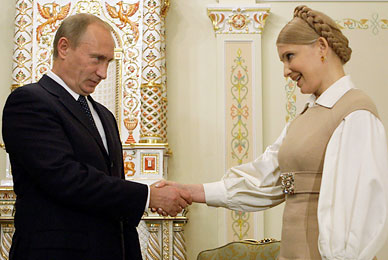
The headline reads: “Putin accuses Ukraine of having assisted Georgia during war”
That’s ….Putin ….accusing Ukraine (Tymoshenko is the Prime Minister) of assisting Georgia against Russia??
Ladies, they’re on our turf now!
In an effort to better understand the food habitats of Panjabi immigrants, Canadian researchers conducted a three-year study on the ingredients used in daily Panjabi meals and food choices made by Panjabi families.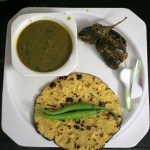
Gwen Chapman, study leader and British Columbia University nutrition professor, stated:
“Since cardiovascular diseases and type II diabetes are more prevalent among Indians and they are linked to food habits, we wanted to understand what ingredients went into daily Punjabi or Indian meals.”
An important part of study was also understanding how cultural affiliations play a role in Panjabi immigrant food choices.
Researchers found that “in Punjabi families in British Columbia … separate meals are often prepared to accommodate elders who need traditional roti, daal and subji, and younger family members who prefer to balance Indian and “Canadian” foods.”
While reading this article I thought about how these food choices actually play out in immigrant Panjabi homes across North America. I remember the rotis without butter for those who have high cholesterol and the weekend meal of burger and fries for us “American” kids. There were also the interesting “masalaa” pastas, lasagnas, and pizzas that had a “Panjabi” twist (i.e. tons of garam-masalaa). I recall uncles’ refusing to eat “kaa-foos” prepared by their wives, aunties making tofu-sabiji, and mothers’ substituting olive oil for vegetable oil when making tarkas. Many of these food choices were an effort to provide more healthy meals as a “preventive” form of action against heart disease and diabetes; while others were made to satisfy taste-buds.
So I was wondering what interesting food choices have you seen Panjabi families make in the Diaspora both to satisfy taste-buds and become more healthy?
As part of its series on the upcoming federal elections in Canada, the Globe and Mail offers this article on the emergence and success of Sikhs in the Canadian political scene. Consider: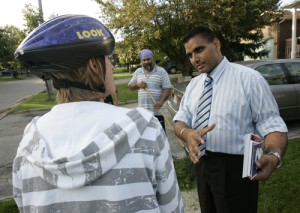
- Sikhs [are] the only group with a greater number of MPs than their share of the population.
- [In the House of Commons,] Punjabi is now the fourth most common language, after English, French and Italian.
- Many Sikh candidates live in Mississauga and Brampton, where they comprise 15 per cent and 19 per cent of the population respectively.
- [There are] 17 Punjabi newspapers in Brampton [Link]
These statistics are very impressive. I applaud the Sikh candidates for their participation in Canadian politics (which cuts against the suggestion that Sikhs are not sufficiently integrating into Canadian society). And I thank this publication for highlighting the political advancements that Sikhs are making in Canada.
That said, I am troubled by two parts of the article:
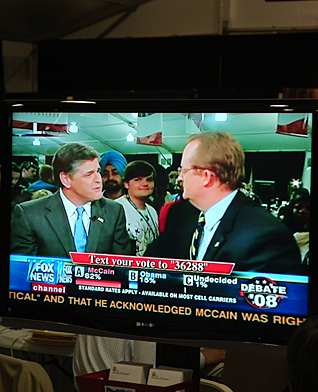 Were you watching the Presidential debate last Friday? Did you catch flashes of a sardar in a blue turban? I assume that anyone who did was equally as surprised as I was (though happily so). Well, who is the mystery man? He’s Arvinder Singh Kang, a twenty five year old who was the only Punjabi, and the only Sikh at the University of Mississipi when he came from Punjab to do a graduate degree.
Were you watching the Presidential debate last Friday? Did you catch flashes of a sardar in a blue turban? I assume that anyone who did was equally as surprised as I was (though happily so). Well, who is the mystery man? He’s Arvinder Singh Kang, a twenty five year old who was the only Punjabi, and the only Sikh at the University of Mississipi when he came from Punjab to do a graduate degree.
I came to the U.S. in the fall of 2005, as a graduate student at the University of Mississippi. From a proud Sikh family, I was the first kid from my village and from my maternal and paternal lineage to come to America for studies.
I brought twenty-something Puggs (turbans). I knew Japji Sahib by heart and had been exposed to Sikh history more than I had been to comics. All through my undergrad years, I had taught my juniors how to wear a turban. There was no doubt, whatever the circumstances might be, I would always be a Turbanator!
While boarding a plane from London’s Gatwick Airport, I sat beside a Sikh girl living in Houston who was born and raised in London. “…So it’s going to be hard to keep a turban in university”, she said in a lovely British accent.
“Much nee te kuch nee!” (What’s a man without a mustache) I had quipped. [link]
You can read more from Arvinder at Sikhchic.
The NYT recently covered the rising admission of Muslim students in Catholic schools, unsurprisingly, because there is a greater freedom to practice their faith in Catholic school than in “secular” public schools:
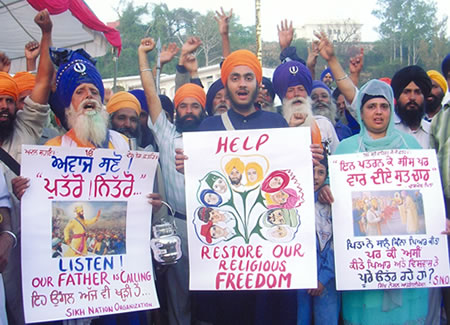
“There is respect for our religion here,” said Nadia Oualane, 14, a student of Algerian descent who wears her hair hidden under a black head scarf. “In the public school,” she added, gesturing at nearby buildings, “I would not be allowed to wear a veil.”
The experience of French Muslims mimics the crushing oppression that Sikhs and other religious minorities face under France’s harsh and discriminatory anti-religious policies:
The quiet migration of Muslims to private Catholic schools highlights how hard it has become for state schools, long France’s tool for integration, to keep their promise of equal opportunity…
Imam Bencheikh’s oldest daughter attends Catholic school. “It’s ironic,” he said, “but today the Catholic Church is more tolerant of — and knowledgeable about — Islam than the French state.”
In a recent state meeting between the French and Indian PMs, Sarkozy and Singh, respectively, reporters used the opportunity to reopen the question of how the religious ban has impacted Sikhs. Sarkozy ignored the disparate impact of the ban by claiming that its uniform application meant it had no discriminatory intent [Hat tip, Tejinder]:
Visibly irritated, Sarkozy continued, “But sir, we have rules, rules concerning the neutrality of civil servants, rules concerning secularism, and these rules don’t apply only to Sikhs, they apply to Muslims or others. They apply to all on the territory of the French Republic.”
His comments, however, about the universal nature of this ban are contradicted by his Minister of National Education, who indicates that there is an explicitly anti-hijab and anti-Muslim intent behind this policy:
“The head scarf is a sexist sign, and discrimination between the sexes has no place in the republican school,” France’s minister of national education, Xavier Darcos, said in a telephone interview. “That is the fundamental reason why we are against it.”
Muslim enrollment in Catholic schools is facilitated, in part, by marginally “freer” religious practice options, but also by the idea of a shared Abrahamanic history and God. Where do Sikhs find refuge, both in the context of education and religious practice, given their distinct history, practice, and interaction with Judeo-Christian institutions? France’s ban has been decried by human rights organizations and religious organizations, but little positive action has taken place against the ban. Indeed, in some cases the State’s reaction seems retaliatory.
Though this may not be the best analogy, I’m going to make it. It seems the Congress party in Haryana made the demand for a separate Gurdwara committee, in order to mobilize Sikh votes in their favor (at least according to one news source).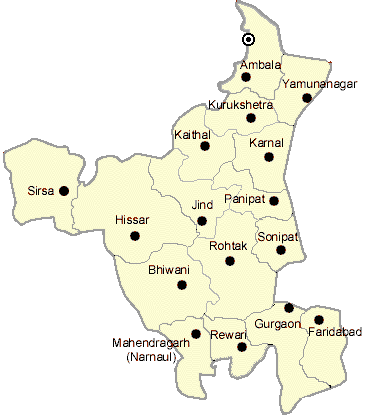
What is also well known is that Haryana’s Sikh vote has traditionally been mobilised by the SAD(B) for Devi Lal and then his son Om Prakash Chautala’s party. After 1984, the anti-Congress vote headed in that direction even more. By all accounts, the 2005 Assembly elections — also the one in which the Congress manifesto included the demand for a separate gurdwara management body for Haryana — constituted a break in the story. According to a CSDS survey, 50 per cent of the Sikh vote in Haryana went to the Congress in 2004, and only 35 per cent to Chautala’s INLD. [link]
And Sarah Palin- as qualified as she may be- was not selected to run as Vice President because of her outstanding qualifications, but for her token status as a woman. It was hoped that she would fulfill the dreams of Hillary supporters who wanted the glass ceiling in the White House shattered. (From what I’ve seen in the polls though, this doesn’t seem to have worked. The women who rallied behind Hillary don’t want a token representative.)
 This post is sort of dedicated to P.Singh. Let me first begin by saying that I agreed with ALL (and I use that word only after re-reading all of his comments) of the points that he made in a prior post (not all of his comments in other posts, but I digress….).
This post is sort of dedicated to P.Singh. Let me first begin by saying that I agreed with ALL (and I use that word only after re-reading all of his comments) of the points that he made in a prior post (not all of his comments in other posts, but I digress….).
However, I did want to revisit the topic of Dr. Pashaura Singh in light of some more news, posit a contrarian viewpoint based on an academic article, and then revisit the question of endowed Sikh chairs.
Update on Dr. Pashaura Singh
On Friday of last week, Sikhs throughout California organized buses down to the UC Riverside campus to protest Dr. Pashaura Singh’s hire as the chair of the endowed Jasbir Singh Saini Chair in Sikh and Punjabi Language Studies. While newspaper articles stated that over 300 people were in attendance, my own eye-witness sources claim that it was in excess of 500.
Earlier today I stumbled on this article in the Montreal Gazette detailing the suspension, and now calls for a speedy trial, for a Sikh boy accused of assault:
The teenager made his first appearance on the charges in Montreal Youth Court yesterday where he pleaded not guilty to three counts alleging he used a kirpan, a Sikh religious object that resembles a dagger, to threaten his schoolmates.
This case comes on the heels of another landmark Quebec case in which Canada’s Supreme Court unanimously voted to protect the right of Sikh school children to wear the kirpan (with some limitations on its use) in 2006.
But did the boy actually draw, or use, his kirpan during the argument? At first blush, it sounds like this was a schoolyard disagreement, but if the boy drew his kirpan it would be incredibly inappropriate, both under dharmic understandings and under school policy. But on reinspection, it’s unclear if this incident actually ever happened, or if this is a racist reaction against the kirpan. The boy’s lawyer, the same man who argued the Supreme Court case for accommodation of the kirpan, believes the reaction is racist:
Grey accused the Montreal police and the Marguerite Bourgeoys school board of “overreacting.” He also said a large part of Quebec society has never accepted the Supreme Court’s decision.
“I think that what we’re witnessing – it’s my opinion and the court will decide – is a deep bias against the kirpan that has never died in Quebec…”
If his lawyer is correct, then this brings up a larger issue: how do inclusion policies and values translate on the ground if a region or group is hostile to accommodation?
Legal protection of the kirpan is vitally important and relevant and worth protecting, but, if this incident did not take place, how many Sikh children will be pressured, harassed, and suspended from schools for exercising their right to practce their faith? In this case, the school board is not an advocate for the Sikh child (and in the previous kirpan case, when the school drafted an accommodation policy it was invalidated by the school board as well); if that democratic channel fails, then how can we support families in this position?
It’s Friday. Hooray! On that note, I think a light hearted post is needed for today. As David Letterman recently pointed out: McCain taking Palin to meet with world leaders at the United Nations this week was like “take-your-daughter-to-work day.” Oooh Snap!
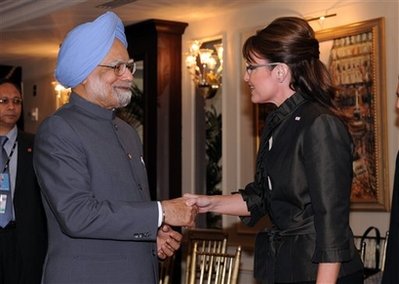
Hopefully Manmohan Singh didn’t gush over Governer’s Palin’s looks as his neighbor did earlier this week!
Enjoy the Presidential Debate tonight and have a good weekend Langarites!
In the aftermath of the September 11, 2001 terrorist attacks, Muslims and Arabs in America engaged in various efforts to respond to the post-9/11 backlash.  For example, in the halls of Congress they advocated against discriminatory security measures and in the courts of law they pressed allegations of employment discrimination and airport profiling.
For example, in the halls of Congress they advocated against discriminatory security measures and in the courts of law they pressed allegations of employment discrimination and airport profiling.
Muslim- and Arab-Americans also turned to another, perhaps less conventional forum: stand-up comedy clubs. For example, a comedy show, “Allah Made Me Funny,” was “an attempt by a group of American Muslim comics to counter the negative stereotypes and attitudes about Muslims and Arabs by poking fun at themselves, their communities and the prejudices they face.” [Link; see also here, here, and here.]
The latest edition of Newsweek contains an article by one Sikh, Narinder Singh, regarding his attempts to use comedy for the same purpose.
Heads-up friends, the season of the “Spinning Wheel Festival” is about to begin across North America this autumn. Celebrating Sikh films and art, the first stop will be in New York City on Saturday, October 04, 2008 at the Asia Society & Museum (p.s. that’s next Saturday). Buy your tickets NOW! The wonderful Rabbi Shergill will be performing at the opening gala (yes I am really biased here … I heart Rabbi Shergill) and DJ Rekha will be literally “spinning” at the after party.
Films a the NYC festival will range from documentaries on Pahelwani (i.e. Panjabi wrestling) and Kaba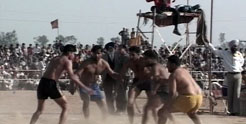 ddi-playing Canadian police officers to issues affecting the Sikh community from 1984 and post-9/11 hate crimes. There will also be short and feature films. For example, one on a young boy’
ddi-playing Canadian police officers to issues affecting the Sikh community from 1984 and post-9/11 hate crimes. There will also be short and feature films. For example, one on a young boy’ s struggle to keep his hair while his family fears the obstacles he will encounter and another on “… a young Sikh doctor struggling with the inequities of the American Health System and ultimately his own identity”. The Holy Duels of Hola Mohalla is a film looking at the Khalsa Panth.
s struggle to keep his hair while his family fears the obstacles he will encounter and another on “… a young Sikh doctor struggling with the inequities of the American Health System and ultimately his own identity”. The Holy Duels of Hola Mohalla is a film looking at the Khalsa Panth.
The films seem interesting both in content and presentation. The stories are grounded in the realities many of us encounter everyday. You can get a full listing of the films and their synopses here.
In the past, I have attended the “Spinning Wheel Festival” at one of its many North American stops and found it a great space for artists and art-enthusiasts to be exposed to Sikh creativity. I remember there being a panel discussion with the directors and the audience. We don’t have too many of these creative opportunities in our community even though we spend plenty of time and space advertising foreign medical schools in Poland, China, and the Caribbean.
I have found that some films are really hit or miss at these festivals, but it’s expected sense the focus is on cultivating and inspiring creativity; while, building a permanent Sikh film festival for years to come. Cash prizes are awarded to the “bests” in various categories. I have been told that the listing and quality of films varies across the different North American stops.
At the end of the day why not go, especially if it’s close by. I personally think it’s worth a visit as an act of supporting Sikh arts and learning about the various issues affecting our community. Sometimes we get too caught up in our own worlds and don’t realize these issues are taking place or we are in amidst of them and they become normal parts of our lives leaving very little room for reflection or exposure to others’ perceptions. Thus, it’s an 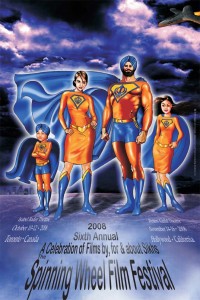 opportunity to get a fresh/new look at various issues.
opportunity to get a fresh/new look at various issues.
Lastly, the arts, from painting and photography to films and music, are our community’s soul! They help us speak in ways we can’t always articulate. So go save your soul and attend a Sikh artistic event! 🙂
Okay, enough of the attempt at convincing … the other North American stops will be:
- Toronto, Canada from October 10-12, 2008 at the Isabel Bader Theatre.
- Hollywood, California from November 14-16, 2008 at the Writers Guild Theatre.
Are ya’ll thinking of going? What have your experiences been at the various Spinning Wheel Festivals? Does anyone know of other North American stops?
p.p.s. The Toronto and Hollywood poster is really interesting isn’t it … a conversation in of itself!
[Joint post by Singh and Reema]
The plot is thick. Nearly 100 million Phillipine pesos are at stake (roughly $ 2.2 million USD). Multiple groups of god-father like figures control entourages of loyal henchmen. Money is being used for unauthorized purposes, and powerful figures have put competitors out of play – risking not just the money, but [dun dun dun]…their lives!
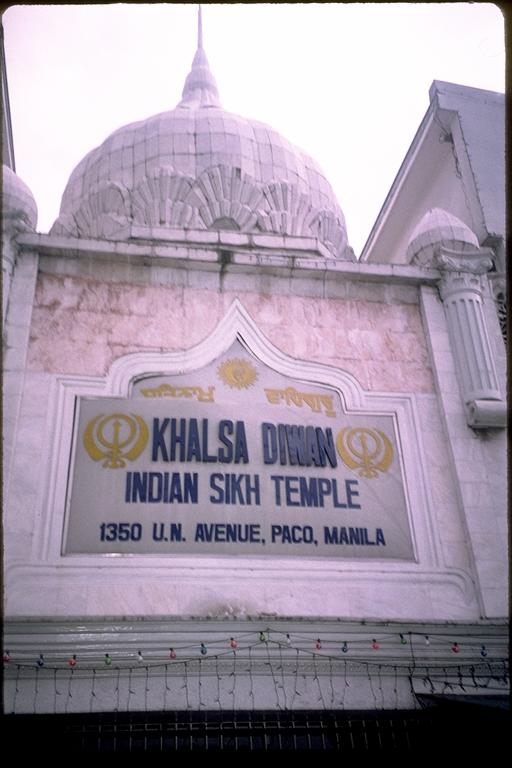
Is this:
(a) The set of Al Capone?
(b) A government paramilitary force under a dictatorship?
(c) The Punjab Police?
(d) Or is it just the story of a gurdwara?
You guessed it: the answer is (d)!
This is the set for the latest episode of “Who Wants to be a Pardhaan (President of the Gurdwara),” and it takes place in Manila, where a battle for control of the local guru ghar has been waged for years. We had heard of this type of thing being publicized in the West (Europe and the Americas), but why should the Phillipines be any different – and undoubtedly this story has just as much drama and un-Sikh-like behavior as any we have heard. It goes something like this:
2004: Bansal became Gurdwara president following a court-supervised elections. After coming into power, he looked into organization’s assets and found that Amardeep’s group (the old committee) had siphoned off P30.6 million from Gurdwara donations to a new corporation they had created—Khalsa Diwan (Sikh Religious Association) Inc.
We are only beginning to hear about the prevalence of postpartum depression in the larger community, so it comes as no surprise to me that we hear about it even less within the South Asian community. Recent research suggests that Indian women, particularly new immigrants, may be at a higher risk of postpartum depression than their non-Indian counterparts. Experts suggest isolation stemming from the immigrant experience and a lack of the traditional support system often found in the home countries, as reasons for increased prevalence among Indian women.
In the United States, about one in 10 women suffers from postpartum depression (PPD). South Asian women may be at a higher risk for PPD, due to the impact of acculturation and cultural customs including factors such as arranged marriage and the gender of the child.
A groundbreaking 2007 study published in the Journal of Obstetrics and Gynecology concluded that 28 percent of Indian American women suffered mild symptoms of postpartum depression and 24 percent suffered major symptoms. The paper-titled “Immigrant Asian Indian Women and Postpartum Depression” is the only study of Indian American women and postpartum depression. [link]
Dr. Nirmaljit Dhami, medical director of the new Maternal Outreach Mood Services program at El Camino Hospital in Mountain View, Calif., says that post-birth, many women present symptoms of tearfulness and crying. Sadness, emptiness, feeling overwhelmed, having a short temper, appetite changes and withdrawal from family and friends are all symptoms common to postpartum depression. [link]
For many of us Sikhs of Panjabi-background, those Sikhs that chose to embrace Sikhi (often termed as ‘goray Sikhs’, but by no means are all of them of such ‘gora’ background) are sometimes seen as an enigma. Too often stereotypes and easy labels such as ‘hippie’ or ‘weird’, knee-jerk opinions on ‘yoga’, or even a certain ‘guilt’ in terms of our own relationship with our Guru tend to be expressed in hushed tones. 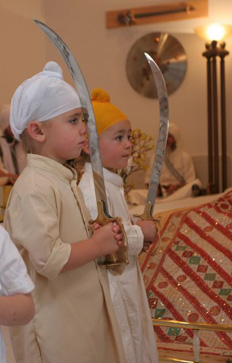 However, such labels only dehumanize those that we should be most embracing as brothers and sisters of a shared Guru.
However, such labels only dehumanize those that we should be most embracing as brothers and sisters of a shared Guru.
A recent article in a local Surrey newspaper recently has me re-thinking how as a Sikh community we can continue to strengthen our Qaum. Reading about Hari Nam Singh Khalsa’s own evolution was not only inspiring, but also a point for reflection.
The Oakville, Ontario resident is the host of the only English-language program on Canadian television that provides knowledge about Sikhi. His “Insight into Sikhism” airs on Saturday mornings throughout Canada (you can click here for Canadian times and channels). On the show’s website, the program’s purpose is described as:
Each week, host HariNam Singh Khalsa explains aspects of the Sikh religion and its relevance to modern day issues. Insight into Sikhism introduces the core principles of Sikhism in a simple and basic format in English for everyone to understand. HariNam Singh’s mission is to spread the universal teachings of Sikhism to people of all faiths.[link]
Although I have never seen the show (if you have, please do comment and let us know your thoughts about it), it seems like a remarkable and much-needed project.
I got this cute video link via ASATA and wanted to share it with TLH. It talks about Italy’s desi-Sikh minority, relations between Italians and Sikhs, and the role of Sikhs in Italy’s cheesemaking industry
A delegation of representatives for the PSGPC traveled to the U.S. and UK to discuss congregational needs, socioeconomics, and Muslim-Sikh relations in Pakistan [ed note: forgive the confusing grammar from the news source; the translation is imperfect].
The delegation did quite a bit of fundraising, and they stopped to check in with several Sikh “community leaders” throughout California, and elsewhere. Largely these were founders or heads of private non-profits, not congregations. It’s hard to discern what actually happened from the news coverage, which focused on explaining “those wacky” Sikhs. However, the group attempted to bring special attention to the disparities in achievement, etc., between Pakistani Muslims and Sikhs.
I finished the article with many more questions than when I started reading it; Why did the committee chose to travel to those two regions? Why were so many of their questions fixated on the ritualistic veins of Sikhi that have begun to penetrate our communities? How did they pick who to visit on their trip? What is the status of Pakistani Muslim-Sikh relations and disparities, today?
Did you hear about this tour from anyone? If so, what did you think?
So recently I came across a blog about all the “Stuff Korean Moms Like”. A Korean girl, Chiyo, who loves her KM (Korean Mom) decided to create this blog “to share the joy and dread of KM”. As I went through the list … I kept thinking about our own PSM’s (Panjabi Sikh Moms) … now now don’t think it’s funny to call our mummies’ PMS that actually stands for Panjabi Male Syndrome!
As I went through the list … I kept thinking about our own PSM’s (Panjabi Sikh Moms) … now now don’t think it’s funny to call our mummies’ PMS that actually stands for Panjabi Male Syndrome!
From corningware to marrying people off and stank eye … I found many similarities between KMs and PSMs (although the differences were stark … I don’t even think many PSMs know what redbean is let alone love it. And when it comes to Jesus … let’s just stick with the Gurus and Waheguruji)!
Inspired by Chiyo’s blog on Korean Moms, let’ start our own list of “Stuff Panjabi Sikh Moms’ Like”! I will begin …
- Tupperware (i.e. I am not just talkin’ about Rubbermaid … I mean sour cream and whipped butter dabhaa). Over time this Tupperware becomes yellow from all the haldhee in sabjis … but soak it in the sun and most of the stains go away. Slowly over time old ones are replaced as new ones are collected.
- Corningware (do I really need say anything more … I think Chiyo’s explanation resonates perfectly with PSMs).
- Zee TV, Sony TV, and Alpha Etc. Punjabi nateekhs (what’s your mom’s favorite soap opera …).
- Noon Dhani (i.e. the steel container with small steel bowls and spoons for all their spices).
- Dhahee (i.e. homemade yogurt … sorry I personally can’t stand the boxed stuff after growing up on my mom’s delicious freshly made dhahee).
- Outrage at the rising cost of Ataa (i.e. flour that is commonly bought at the Indian store to make roti).
- House-walls that are painted hospital white … look how clean and simple they look. The rooms feel much more lighted with this color.
- Overstuffing Family And Friends With Food … lai if they leave your house without a food-coma, they did not have a good-time.
- Cooking your favorite Panjabi dish when you come home from college. It’s a sign of how much she missed you.
- The ten Gurus’ pictures, particularly those of Guru Nanak Dev Ji and Guru Gobind Singh Ji, are the number one home-decorating items.
Please add to the list ( it’s in no particular order)! What do you think Panjabi Sikh Mom’s really like? I know many of you must have your own favorites! 🙂
Disclaimer: Please keep it clean, respectful, and hate-free … I really should not have to say this, but unfortunately in the virtual world people often display a “holds-no-bar” attitude when commenting on issues like this one.
This day marks the 221th anniversary of the signing of the U.S. Constitution.
No matter how much we argue about the details of its meaning today, in the opinion of many, the Constitution signed in Philadelphia on September 17, 1787 represents the greatest expression of statesmanship and compromise ever written. In just four hand-written pages, the Constitution gives us no less than the owners’ manual to the greatest form of government the world has ever known. [Link]
To commemorate this historic day, the U.S. Congress designated September 17 as “Constitution Day” and required all schools that receive federal financial assistance to “provide some educational programming about the U.S. Constitution on or around Sept. 17[.]” Despite the brilliance of the American constitutional system and the congressional mandate for schools to study the Constitution on at least one day, ignorance of the American government remains high. For example:
- When asked to name two of Snow White’s Seven Dwarfs and two of the nine U.S. Supreme Court Justices, 77% of Americans polled were able to identify two dwarfs, while only 24% could name two Supreme Court Justices.
- 73% of those polled [were] able to name all three of The Three Stooges, while only 42% could name the three branches of government. [Link]
Further, more American teenagers
- know the Fresh Prince of Bel-Air than know the Chief Justice of the Supreme Court (94.7% to 2.2%)
- know which city has the zip code “90210” than the city in which the U.S. Constitution was written (75% to 25%) [Link]
These and similar statistics should alarm Americans and they reflect the need for greater civics education in American schools. But we should not think that this is a concern from which Sikhs are exempt.

